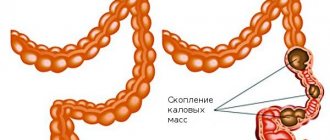Description:
Transparent viscous liquid from colorless to yellow with a brownish tint.
Pharmacotherapeutic group:
laxative.
ATX code:
A06AD11.
Pharmacological properties
Pharmacodynamics
It has a hyperosmotic laxative effect, stimulates intestinal motility, improves the absorption of phosphates and calcium salts, and promotes the excretion of ammonium ions.
Lactulose is broken down by the intestinal flora of the colon into low molecular weight organic acids, which leads to a decrease in pH and an increase in osmotic pressure and, as a result, an increase in the volume of intestinal contents. These effects stimulate intestinal motility and affect stool consistency. The physiological rhythm of emptying the large intestine is restored.
In hepatic encephalopathy and hepatic (pre)coma, the effect is due to the suppression of proteolytic bacteria by increasing the number of acidophilic bacteria (for example, lactobacilli); the transition of ammonia into ionic form due to acidification of the contents of the colon; bowel movements due to a decrease in pH in the colon and the osmotic effect; as well as reducing nitrogen-containing toxic substances by stimulating bacteria that utilize ammonia for bacterial protein synthesis.
Lactulose as a prebiotic substance enhances the growth of beneficial bacteria such as bifidobacteria and lactobacilli, which in turn helps to suppress the growth of potentially pathogenic bacteria such as Clostridium and E.coli, and provides a more favorable balance of intestinal flora.
Has the ability to inhibit the growth and reproduction of salmonella and shigella. Does not reduce the absorption of vitamins and is not addictive.
The effect occurs 24-48 hours after administration (the delay is due to the passage of the drug through the gastrointestinal tract).
Pharmacokinetics
Absorption is low (renal excretion is 3%). Without being absorbed, it reaches the large intestine, where it is broken down by intestinal flora. Completely metabolized at doses of 40-75 ml; at higher dosages, it is partially excreted unchanged through the intestines.
Lactulose-ratiopharm 200 ml syrup
Instructions for medical use of the drug Lactulose-ratiopharm Trade name Lactulose-ratiopharm International nonproprietary name Lactulose Dosage form Syrup 66.7 g/100 ml 200 ml Composition 100 ml of solution contain the active substance - lactulose 50% 132.00 g Description Transparent, colorless or slightly brownish-yellow viscous liquid Pharmacotherapeutic group Laxatives. Osmotic laxatives. Lactulose ATC code A06AD11 Pharmacological properties Pharmacokinetics When taken orally, the absorption of lactulose is low. In unchanged form, lactulose reaches the large intestine, where it is broken down by intestinal flora into low molecular weight organic acids. Completely metabolized at doses of 25-50 g or 40-75 ml; at higher dosages, it is partially excreted unchanged by the kidneys. Pharmacodynamics Products of lactulose metabolism help lower the pH of the colon lumen and have a hyperosmotic effect, resulting in an increase in the volume of intestinal contents. This stimulates intestinal motility and normalizes stool consistency. As a result, constipation is eliminated and the physiological rhythm of the large intestine is restored. In hepatic encephalopathy or hepatic (pre)coma, the therapeutic effect is explained by the following mechanisms: inhibition of the growth of proteolytic bacteria due to the proliferation of acidophilic bacteria (for example, lactobacilli), uptake of ammonia in ionic form through oxidation of the colon contents, bowel emptying due to the low pH value of the colon contents and osmotic effect, as well as the utilization of ammonia for intracellular protein synthesis as a result of changes in the bacterial metabolism of nitrogenous compounds. Lactulose-ratiopharm as a prebiotic substance enhances the growth of beneficial bacteria, such as bifidobacteria and lactobacilli, and inhibits the growth of potentially pathogenic bacteria, such as clostridium and E. coli. This may create a more favorable balance of intestinal flora. Indications for use - constipation (regulation of the physiological rhythm of the large intestine) - conditions requiring softening of the stool for medical purposes (hemorrhoids, condition after surgery on the colon and perianal region) - hepatic encephalopathy (treatment and prevention of hepatic coma or precoma) Method of administration and dosage The dose of the drug is selected individually depending on the therapeutic effect. The syrup can be taken undiluted or diluted in water or other liquids, regardless of meals. The laxative effect may appear after 2-10 hours. For the treatment of constipation and softening of stools, the daily dose can be taken once or divided into two doses using a measuring cap. After a few days from the start of treatment, you can switch to a maintenance dose, depending on the therapeutic effect. It may take 2-3 days for the therapeutic effect to develop. Age Initial dose, per day Maintenance dose, per day Adults and adolescents 15-45 ml 15-30 ml Children 7-14 years old 15 ml 10-15 ml Children 1-6 years old 5-10 ml 5-10 ml Infants under 1 year up to 5 ml up to 5 ml For the treatment of hepatic coma and precoma in adults. The dosage should be with a gradual increase. The drug is prescribed in 7.5-15 ml (corresponding to 5-10 g of lactulose) 3-4 times a day. Then the dose is gradually increased to 30-45 ml (corresponding to 20-30 g of lactulose) 3-4 times a day, until soft stools are achieved 2-3 times a day. The course of treatment with Lactulose-ratiopharm should be continued until the symptoms of the disease are eliminated and laboratory parameters are normalized. Side effects Very often - nausea, vomiting, abdominal pain, flatulence in the first days of taking Lactulose-ratiopharm, which goes away after two days - diarrhea (when using high doses) Very rarely - water-electrolyte imbalance - convulsions - headache, dizziness - arrhythmias - myalgia - increased fatigue - hypernatremia (with hepatic encephalopathy) Contraindications - hypersensitivity to lactulose - acute inflammatory gastrointestinal diseases - intestinal obstruction, perforation or risk of perforation of the gastrointestinal tract - suspected appendicitis - rectal bleeding - colostomy, ileostomy - disorders water-electrolyte balance - galactose intolerance, Lapp lactase deficiency syndrome or glucose and galactose malabsorption syndrome) - pregnancy and lactation Drug interactions With simultaneous use of the drug Lactulose-ratiopharm and: - diuretics, corticosteroids, amphotericin B - increased loss of potassium - cardiac glycosides - enhancing the effect of glycosides - drugs that have a release dependent on the pH of the colon (such as 5-aminosalicylic acid preparations) - they may be inactivated as a result of a decrease in the pH of the colon. Special instructions If the therapeutic effect is insufficient within a few days after taking the drug, you should consult your doctor again. The drug Lactulose-ratiopharm should be prescribed with caution to patients with lactose intolerance. Lactulose-ratiopharm should be prescribed with caution in diabetes mellitus. The dose of Lactulose-ratiopharm used in the treatment of hepatic precoma and coma is usually much higher and therefore, when prescribing the drug to patients suffering from diabetes, it may be necessary to take into account the amount of lactulose. In elderly and debilitated patients taking lactulose for more than 6 months, it is recommended to regularly determine the concentration of blood electrolytes. If diarrhea occurs, treatment is discontinued. It is not recommended to take lactulose within 2 hours after taking other medications. In children, laxatives are used in exceptional cases and under medical supervision. It should be taken into account that in children the defecation reflex may be impaired as a result of treatment. The safety and effectiveness of use for hepatic encephalopathy in children under 18 years of age has not been established. Features of the effect of the drug on the ability to drive a vehicle or potentially dangerous mechanisms Lactulose-ratiopharm does not affect the ability to drive a car or potentially dangerous mechanisms. Overdose Symptoms: abdominal pain, diarrhea, electrolyte imbalance. Treatment: discontinuation or reduction of the dose of the drug, if necessary, correction of the electrolyte balance. Release form and packaging 200 ml of the drug is poured into polyethylene bottles with a screw cap. 1 bottle, along with a measuring cup and instructions for medical use in the state and Russian languages, is placed in a cardboard box. Storage conditions Store at a temperature not exceeding 25°C. Keep out of the reach of children! Shelf life: 3 years. The period of use of the drug after opening the bottle is 12 months. Do not use after the expiration date. Conditions for dispensing from pharmacies Without a prescription, Austria Packer "Merkle GmbH", Germany Owner of the registration certificate "ratiopharm GmbH", Germany Address of the organization that accepts claims from consumers on the quality of products (products) in the territory of the Republic of Kazakhstan Ratiopharm Kazakhstan LLP, 050040, g Almaty, Al-Farabi Ave., 19, BC Nurly-Tau, 1B, office 603, telephone, fax, e-mail
Directions for use and doses
The drug is intended for oral administration,
during or after meals.
Lactulose may be given as a single daily dose, or the dose may be divided into two doses using a measuring cup.
All dosages must be selected individually. If one dose is prescribed per day, it should be taken at the same time, for example, during breakfast.
For constipation:
- children under 1 year: 5 ml/day;
- children from 1 to 6 years: 5-10 ml/day;
- children from 7 to 14 years: 15 ml/day;
- children over 14 years of age and adults: in the first three days, 15-45 ml/day, then 10-30 ml/day.
The laxative effect of the drug develops during the first two days of administration. The duration of treatment is from 4 weeks to 3-4 months.
With hepatic coma, (pre)coma, encephalopathy
:
The initial dose is 30-45 ml 3 times a day. Then the dose is selected so that soft stools are produced 2-3 times a day. Treatment can last up to 3 months or more.
For hepatic coma, (pre)coma and hepatic encephalopathy: 30-50 ml orally 3 times a day, the daily dose can be 90-190 ml; then in an individually selected maintenance dose (providing a stool pH of 5-5.5) 2-3 times a day.
In the postoperative period
:
Adults: 10-30 ml 3 times a day, children over 1 year: 5-10 ml 2-3 times a day, up to 1 year: 5 ml 2-3 times a day. The drug is prescribed 18-24 hours after surgery for 3-5 days.
Lactulose for children
The fact that lactulose can be beneficial for children was established by pediatricians in Austria back in the late 1940s. Observing bottle-fed babies, we noticed that dysbacteriosis occurs in such babies several times more often than in babies fed breast milk. After a series of experiments, it turned out that human milk contains lactulose, and this, in turn, provides healthy intestinal microflora.
Chemists have learned to synthesize this substance from lactose. And pharmacists introduce it into syrups that improve the microflora of children's intestines. This syrup can be given to children of all ages. The instructions for use describe in detail the dosages for each age group.
For adults, lactulose is available in the form of dietary supplements, laxative tablets, and other pharmaceutical forms. At the same time, the effect on the body is the same.
Side effect
Side effects are usually mild and reversible and are a consequence of exceeding the dose.
In the first days of taking lactulose, flatulence may occur, which, as a rule, disappears after 1-2 days. If high doses are used for a long time in the treatment of hepatic encephalopathy, the patient may develop electrolyte imbalances as a result of diarrhea and, as a result, convulsions, flatulence, nausea, headache, dizziness, arrhythmia, myalgia, increased fatigue, and weakness.
Symptoms of deficiency and excess
The leading clinical sign of insufficient lactulose intake is the presence of persistent constipation. The problem disappears spontaneously when taking a prebiotic for several days. Other symptoms of nutrient deficiency include:
- attacks of nausea and vomiting;
- a sharp decrease in body weight;
- unpleasant sensations in the abdomen, flashes of pain.
Disorders of the gastrointestinal tract provoke metabolic disorders and improper functioning of the digestive organs.
If the recommended amounts of lactulose are exceeded, the consequences are unpleasant, but do not cause significant dysfunction of the body. Excessive consumption of fermented milk products and dietary supplements leads to the formation of a chronic form of diarrhea, active gas formation (flatulence) and rapid weight gain. There is a risk of inflammatory processes in the urinary organs, requiring long-term treatment.
special instructions
If there is no therapeutic effect within two days or if constipation returns after treatment, the patient is advised to consult a doctor.
The drug should be administered with caution to patients with galactose intolerance. Please note that the drug may contain small amounts of bound sugars (for example, lactose, galactose, epilactose).
When treating hepatic (pre)coma, higher doses of the drug are usually prescribed, which should be taken into account in patients with diabetes mellitus.
When treating children, laxatives should be used in exceptional cases and under medical supervision. It must be taken into account that during treatment, disorders of the emptying reflex may occur.
Patients with rare congenital disorders such as galactose intolerance, Lapp lactase deficiency or glucose-galactose malabsorption should not use this drug.
With long-term use of the drug (more than 6 months), the concentration of potassium, chlorine and carbon dioxide in the blood plasma should be regularly monitored.
For gastrocardial syndrome, doses should be increased gradually to avoid flatulence.
The body's needs for prebiotics
When used regularly, lactulose increases the number of beneficial bacteria tenfold, while simultaneously reducing the number of harmful microbes by a hundredfold. To obtain a similar effect, daily use of dietary supplements with a prebiotic is required. The daily intake of the substance is 3-4 g for an adult.
Taking lactulose is justified for patients:
- with chronic constipation;
- dysfunction of the gastrointestinal tract;
- increased activity of pathogens in the intestines;
- liver dysfunction;
- elevated cholesterol levels;
- unstable metabolism - regular slowdown of metabolism.
The use of lactulose requires special caution in case of diabetes mellitus, increased or decreased acidity of gastric juice. The presence of these pathologies requires restrictions on the consumption of any fermented milk products or the intake of dietary supplements.
Lactulose is a substance that combines optimally with minerals. When taking the drug, accelerated absorption of individual elements in the intestine is observed. The list includes iron, calcium, magnesium, zinc. The prebiotic optimizes the production of secondary bile acids and lowers levels of bad cholesterol in the body.
Food sources
The list of foods rich in lactulose does not only include dairy products. Although, of course, there are more substances in this category. So, to enrich the body with a useful prebiotic, it is important to pay attention to breast milk, natural yoghurts, cottage cheese, bananas and rye bran. Cauliflower, broccoli, asparagus, corn, beans and even onions or garlic can be used as sources of this beneficial substance. Sweet lovers can replenish their prebiotic reserves from dried apricots and black currants.
Lactulose for weight loss
Best materials of the month
- Coronaviruses: SARS-CoV-2 (COVID-19)
- Antibiotics for the prevention and treatment of COVID-19: how effective are they?
- The most common "office" diseases
- Does vodka kill coronavirus?
- How to stay alive on our roads?
Perhaps half of overweight people dream of a miracle diet that will help them lose 5 or even 10 extra pounds in a week. Nutritionists, hearing this, say: “Nonsense! This cannot be! But advertising promises something else. Most drugs that quickly get rid of excess weight work on the principle of a laxative. For this reason, lactulose is sometimes also used inappropriately. By consuming drugs based on this substance, obese people want to achieve a laxative effect to reduce weight.
But a laxative, even the strongest one, has no effect on fat deposits. And false weight loss occurs only due to loss of moisture. Continuing this “weight loss” for several days, the only result that can be achieved for sure is dehydration and leaching of nutrients from the body. And even the beneficial properties of lactulose will not save the situation.
But there are options when lactulose can be taken for weight loss, or more precisely, as an adjuvant. When following a diet, especially if there are few foods rich in fiber in the diet, constipation often occurs. This is where lactulose comes to the rescue - it will help quickly remove waste products from the body, cleanse the intestines and take care of the correct microflora. As a result, this will affect your overall well-being, increase your tone and strengthen your immune system. This means you will have the strength to exercise, without which there will definitely be no effective weight loss.








